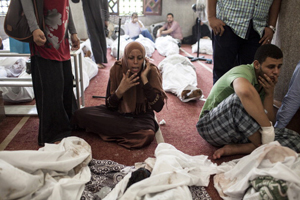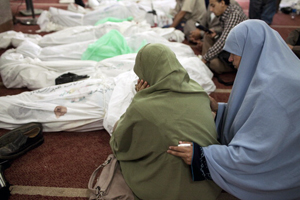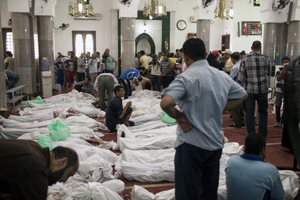Egypt’s Disastrous Bloodshed Requires Urgent Impartial Investigation
 Amnesty International – There must be a full and impartial investigation into the violent dispersal of sit-in protests in Cairo this week, where security forces used unwarranted lethal force and broke promises to allow the wounded to exit safely, Amnesty International said today on the basis of its research on the ground.
Amnesty International – There must be a full and impartial investigation into the violent dispersal of sit-in protests in Cairo this week, where security forces used unwarranted lethal force and broke promises to allow the wounded to exit safely, Amnesty International said today on the basis of its research on the ground. “While some protesters used violence, the authorities’ response was grossly disproportionate, seemingly not differentiating between violent and non-violent protesters. Bystanders were also caught-up in the violence.
“While some protesters used violence, the authorities’ response was grossly disproportionate, seemingly not differentiating between violent and non-violent protesters. Bystanders were also caught-up in the violence. “There were dozens of dead bodies and hundreds of injured people. They mostly sustained live ammunition wounds to the upper part of the body,” a doctor told Amnesty International.
“There were dozens of dead bodies and hundreds of injured people. They mostly sustained live ammunition wounds to the upper part of the body,” a doctor told Amnesty International.Other eyewitnesses reported that the heavy gunfire outside the hospital prevented the safe exit of the wounded, and led to the death of a hospital security guard.
Amnesty International is calling for UN experts – especially the Special Rapporteur on extrajudicial, summary or arbitrary executions – to be given access to the country to investigate the circumstances of the violence and the pattern of excessive and unwarranted lethal force used by the Egyptian authorities since the “25 January Revolution”.
BackgroundAs of Friday morning, Egypt’s Health Ministry reported 638 deaths across Egypt. Of these, 288 were in the Nasr City neighbourhood, the site of the main pro-Morsi sit-in at Rabaa al-Adawiya Square. This makes it the bloodiest single incident since the outbreak of the “25 January Revolution” more than two years ago.By contrast, during the 18 days of the “25 January Revolution” in 2011, a total of 846 people were killed, according to official statistics.The dispersal followed repeated threats by the Egyptian authorities to remove pro-Morsi protesters described as “terrorists” endangering “national security”. The smaller Nahda sit-in by Cairo University was cleared relatively quickly, while the operation to disperse the Rabaa al-Adawiya sit-in took about 10 hours of protracted clashes.Around Cairo, three media workers were among the dead, and to Amnesty International’s knowledge, at least three female protesters and one child were killed on 14 August. Clashes were reported in Giza and numerous other neighbourhoods across Egypt.Members of the armed forces denied Amnesty International access to the Ta’min al-Sihi Hospital, which reportedly received 52 corpses of those killed in the clashes, including at least one woman. It also dealt with more than 200 injuries – at least half of which required the injured to be hospitalized for treatment.Workers at Cairo’s Zeinhum morgue told Amnesty International that by 10 am on Thursday, 108 autopsies had been carried out, and the facility was overflowing with corpses.On 15 August, Amnesty International researchers visited the Iman Mosque, which was converted into a makeshift morgue after family members brought in relatives killed in the Rabaa al-Adawiya sit-in, as well as some of those evacuated from Rabaa al-Adawiya hospital.At the time of the visit, there were 98 dead bodies inside, among them eight charred corpses – it is unknown whether they were burnt alive or after dying. Lists with names of 265 people had been hung on the mosque’s walls. Volunteers said that two more unidentified bodies had been brought in.Egypt’s Minister of Interior justified the security forces’ conduct, claiming that protesters used violence, and that 43 members of the security forces, including 18 officers, were killed across the country, with more than 200 injured. He claimed that the security forces provided warnings, and only used teargas until fired upon by pro-Morsi protesters.Particularly following the dispersals of the sit-ins, some Morsi supporters did use violence, including firearms, and launched attacks on the Giza Governorate building, police stations and security personnel. Police stations in Waraq and Kerdassa were attacked, with police officers captured, killed and beaten. In several instances, members of the security forces were captured and beaten, and one grieving relative told Amnesty International that her cousin, a police officer, was decapitated on 14 August in Giza.Protesters at Rabaa al-Adawiya told Amnesty International that they used rocks and Molotov cocktails and set police vehicles alight in an attempt to prevent the dispersal.Amnesty International also called on the Egyptian authorities to take immediate measures to improve security for Christians and other minorities amid an alarming rise in sectarian violence against Coptic Christians, seemingly in retaliation for their alleged support of the decision to oust Mohamed Morsi – including attacks on churches, businesses and homes in several governorates. The organization has documented previous instances where the security forces have failed to protect Coptic Christian communities from such attacks.










No comments:
Post a Comment